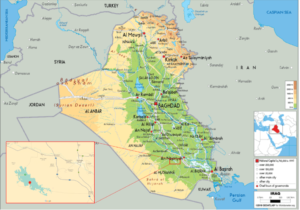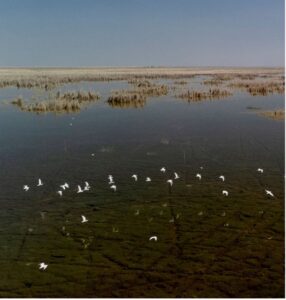IC3+ investigates the marshlands of al-Salibiat in the south of Iraq on the border between Muthana and DhiQar provinces, once a critical resource for local fishermen and buffalo breeders have become a focal point for environmental degradation, migration, and social unrest. After the Iraqi Ministry of Agriculture leased the marsh to a private investor in 2015, the region has seen escalating conflicts over access to water and resources, sparking protests, violence, and the forced migration of families who have relied on the marsh for generations.
Al-Salibiat Marsh is located southwest of Al-Khidhir District in Al-Muthanna Province, approximately 30 kilometers from Samawa City and 60 kilometers from Nasiriyah. Situated to the right of the Euphrates River, the marsh spans the desert region between Al-Muthanna and DhiQar provinces. Al-Salibiat Marsh is a tectonic or erosion basin, stretching 71 kilometers in length, 23 kilometers in width, and ranging from 75 centimeters to 4 meters in depth. It is primarily fed by the Amir River, which draws water from the Atshan River.

The lease of Al-Salibiat Marsh for agricultural investment in 2015 was intended to bring economic benefits, but it quickly became a point of contention. Locals who depend on fishing and buffalo breeding saw the decision threatening their livelihoods. The absence of consultations with these communities only deepened their concerns.
Migration and Livelihoods Under Threat
The marsh had long served as a vital resource for the locals, and fears of restricted access soon proved justified. Disputes between fishermen and private investors grew, leading to violent confrontations and social instability. These tensions eventually required the intervention of security forces, as the conflict began to tear apart the social fabric of the region.
One of the most visible consequences of the conflict has been the migration of families who could no longer sustain themselves in the marshlands. With water levels dropping and access to the marsh restricted, many buffalo breeders and fishermen were forced to leave in search of better conditions. In some cases, families lost most of their livestock due to drought, leading them to relocate to areas with more abundant water.
The drying of the marsh has had a devastating impact on the local population. Many families who relied on fishing and breeding buffalo saw their income and way of life disappear. Estimates suggest that dozens of families have already left the region, while many more are considering migration as resources continue to dwindle.
Water Shortages and Environmental Decline
A critical issue exacerbating the crisis at Al-Salibat Marsh is the ongoing water shortage. The water allocation to the marsh has been insufficient, leading to a dramatic decline in water levels and a deterioration of the local ecosystem. Without enough water, the marsh has dried out in many areas, creating an unsustainable environment for the buffaloes and fish that residents depend on.
The Water Resources Authority, which oversees water distribution across the country, was not involved in the initial leasing agreement, which further complicated efforts to maintain water levels in the marsh. This oversight has contributed to the environmental degradation of the marshlands, threatening both wildlife and human livelihoods.
Alongside the water shortage, unregulated fishing practices have become a major problem. Fishermen in the marsh report widespread use of illegal methods such as poisons and electric fishing, which have a devastating effect on the ecosystem. These techniques destroy fish eggs and disrupt the natural balance of species, leading to a sharp decline in fish populations. The impact of these practices is compounded by the influx of hybrid fish from commercial fishing operations, which has further diminished the availability of local fish. This combination of overfishing, illegal practices, and environmental stress has pushed the marsh’s ecosystem to the brink.
Impact on Wildlife and Migratory Birds
The ecological degradation of Al-Salibat Marsh has also affected Iraq’s wildlife, particularly migratory birds. The marshlands were once a haven for a variety of bird species, including those migrating from Europe and Asia. However, the use of illegal hunting methods, such as electric traps and poisoned bait, has decimated bird populations. This loss of birdlife not only disrupts the natural cycle of the marsh but also threatens the biodiversity of the region. Conservation efforts to protect these species have been limited, and without stronger enforcement of hunting regulations, the future of migratory birds in Iraq’s marshlands remains uncertain.
Amid the growing environmental and social crises, there have been calls to restore the marsh to its natural state. Proposals have been made to designate the marsh as a protected area or natural reserve, a move that could provide legal protection against further exploitation and help regulate the use of the marsh’s resources.

Plans to turn the marsh into a reserve would involve removing barriers that restrict water flow, thereby restoring the natural hydrological cycle of the marsh. Proponents of the plan argue that this would improve both the environmental health of the marsh and the livelihoods of the local population, who depend on its resources. However, past attempts to establish similar reserves in Iraq have struggled due to limited resources and political will. Some observers express doubt that the restoration efforts will be successful without significant investment in infrastructure and community support.
A Fragile Future
The situation at Al-Salibiat Marsh highlights the broader environmental challenges facing Iraq. The combination of water shortages, environmental degradation, and social conflict creates a complex and precarious situation. For the local population, the future is uncertain, as water levels continue to fall and access to vital resources remains restricted. Efforts to address the crisis will require a comprehensive approach that includes sustainable management of the marshlands, proper regulation of fishing and hunting practices, and ensuring the allocation of adequate water resources. Without these measures, the marshlands risk becoming another casualty of Iraq’s growing environmental challenges.
The future of Al-Salibiat remains uncertain, but it serves as a powerful reminder of the need for thoughtful environmental stewardship and the protection of natural resources in a country that is already facing the harsh impacts of climate change and water scarcity. The lessons learned here could be crucial in shaping the future management of Iraq’s other marshlands and natural ecosystems.
![Iraq Climate Change Center [IC3+]](https://iraqclimatechange.org/wp-content/uploads/2024/06/logo2.png)
